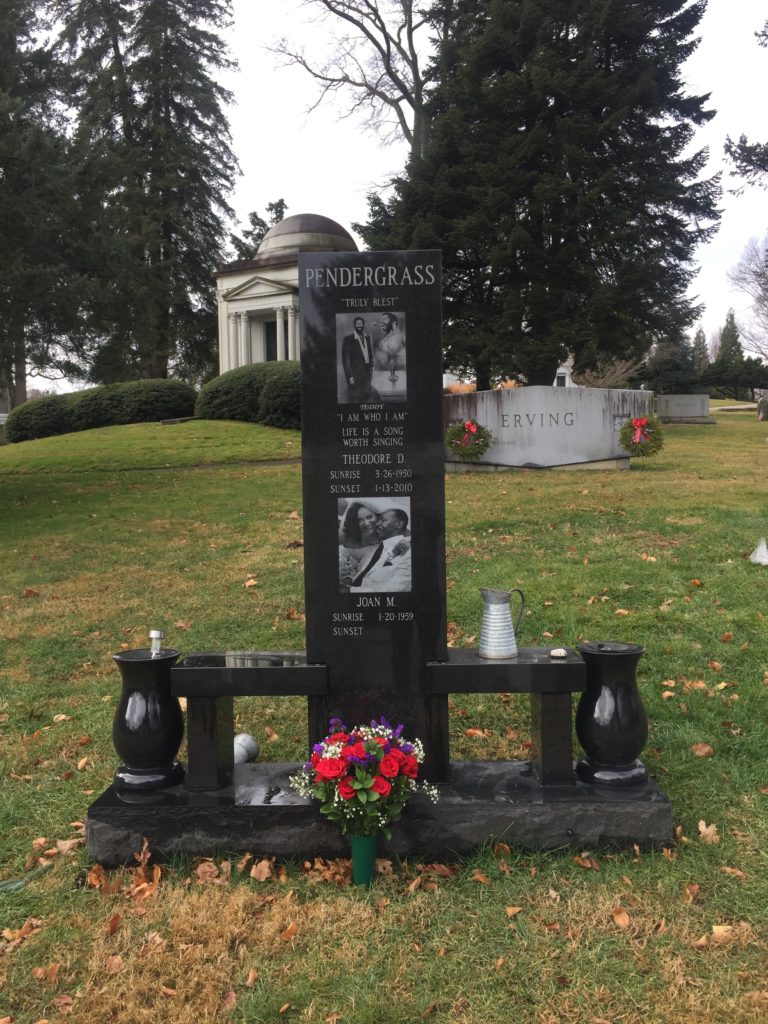Erik Visits an American Grave, Part 1,271
This is the grave of Teddy Pendergrass.

Born in Kingstree, South Carolina in 1950, Pendergrass grew up with a single mother. It’s kind of a sad story, the way it is told. His parents had tried forever to have a child but miscarriage after miscarriage took place. Then, his father walked out of them shortly after Teddy was born. The young Pendergrass was obsessed with finding his father and his mother promised she would do it. They found him in 1961 and Teddy met him. Shortly after, his father was killed in a bar fight. So Teddy wouldn’t really have a father.
Well, Teddy and his mother moved to Philadelphia and grew up in the poor Black community there. This was the peak era of urban renewal and redlining and whites were fleeing toward the suburbs thanks to government subsidies of their new lifestyle, leaving the city impoverished. This was the world in which Pendergrass grew up. He and his mother were in the church and Pendergrass both sang and played drums in their church. He was also a junior deacon in the church.
What Pendergrass really wanted was to go into the music business and he dropped out of high school to do so. He played around a bit in a bunch of bands that didn’t do anything, which is normal. But in 1970, he joined Blue Notes, when Harold Melvin convinced him to play drums for them. This was a good move. He sang some background and soon blew Melvin away. Pendergrass became their lead singer soon after. Putting Pendergrass behind the mic soon got the band a record deal. Their first hit was with “I Miss You” in 1972, a slow weepy ballad that included Pendergrass’ rough baritone and Lloyd Parks’ falsetto. That got a lot of attention and set them up perfectly for their follow up. “If You Don’t Know Me By Now” was a top 10 hit and reached #1 on the soul charts. They had a series of hits over the next few years–“The Love I Lost,” “Don’t Leave Me This Way,” “Bad Luck,” “Wake Up Everybody.” But Blue Notes was doomed as a band and for the most obvious reason. Melvin thought it was his band. Pendergrass knew the reason the band was popular was because of him. They fought over money and band leadership. Pendergrass left and Melvin couldn’t find anyone else who could even come close to Pendergrass’ skill.
In 1977, Pendergrass released his eponymous debut album. This was just as disco was hitting big and Pendergrass had no problem adopting that sound. “I Don’t Love You Anymore” was a huge hit on the dance floor. His follow up album Life is a Song Worth Singing was an even bigger hit. “Only You” and “Close the Door” were huge sellers. The album hit #1 and went double-platinum. And while Pendergrass might have come out of the church, he was now a massive sex symbol, perhaps the biggest in music in the late 70s and he was not apologizing for that either. His manager set him up to play only shows for women and he was super popular across racial categories with the ladies. Some took to calling him the Black Elvis. He loved it and bought a Graceland-esque mansion in the Philly burbs.
However, the biggest star in the world also had the same vulnerable body as the rest of us. In 1982, he was driving his brand new Rolls Royce when the brakes failed. He was sober, so it really was a brake failure. It was a one-car accident, he hit a tree, and was paralyzed from the waist down. It was devastating.
After three years of recovery, Pendergrass made his comeback. Obviously things were different. He wasn’t going to be the sex symbol he once was. But he could still sing. He returned to perform at Live Aid in Philadelphia. The crowd went nuts. He then recorded a new album and scored his last hit with “Reach Out and Touch,” a Diana Ross cover. It reached #1 on the R&B charts and #77 on the pop charts. But the music had changed. Disco was out. Pendergrass didn’t change his style too much and it was hard for him to compete with younger artists. He still recorded and still has his fans, but they were aging as he was. He did work to change his style over time, embracing new jack swing in the 90s and recording a minor hit with “Believe in Love” in 1994. He received the last of his five Grammy nominations for Best Male R&B Vocal Performance that year, but he never did win the award.
As time passed, Pendergrass’ health slowly declined. He stopped performing in 2006, except for one brief appearance at a tribute to him. He contracted colon cancer and underwent a procedure for it in 2009. That actually turned out pretty well, but he soon had respiratory problems that he might have picked up in the hospital. In any case, he had to return to the hospital. He slowly declined and died in 2010, at the age of 59.
Let’s listen to some Teddy Pendergrass.
Teddy Pendergrass is buried in West Laurel Hill Cemetery, Bala Cynwyd, Pennsylvania.
If you would like this series to visit more R&B singers, you can donate to cover the required expenses here. In 2021, Pendergrass was inducted into the R&B Hall of Fame, which is located in Quitman County, Mississippi. Richard “Popcorn” Wylie is in Detroit and Percy Sledge is in Baton Rouge, Louisiana. Previous posts in this series are archived here.


